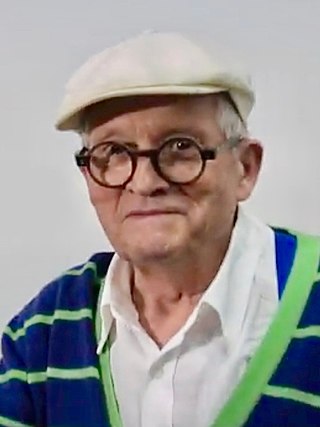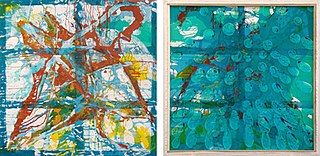Related Research Articles

Paul Jackson Pollock was an American painter. A major figure in the abstract expressionist movement, Pollock was widely noticed for his "drip technique" of pouring or splashing liquid household paint onto a horizontal surface, enabling him to view and paint his canvases from all angles. It was called all-over painting and action painting, since he covered the entire canvas and used the force of his whole body to paint, often in a frenetic dancing style. This extreme form of abstraction divided critics: some praised the immediacy of the creation, while others derided the random effects.

David Hockney is an English painter, draughtsman, printmaker, stage designer, and photographer. As an important contributor to the pop art movement of the 1960s, he is considered one of the most influential British artists of the 20th and 21st centuries.

Richard William Hamilton was an English painter and collage artist. His 1955 exhibition Man, Machine and Motion and his 1956 collage Just what is it that makes today's homes so different, so appealing?, produced for the This Is Tomorrow exhibition of the Independent Group in London, are considered by critics and historians to be among the earliest works of pop art. A major retrospective of his work was at Tate Modern in 2014.

Gordon Frederick Walters was a Wellington-born artist and graphic designer who is significant to New Zealand culture due to his representation of New Zealand in his Modern Abstract artworks.
Events from the year 1974 in art.
Derek Boshier was an English artist, among the first proponents of British pop art. He worked in various media including painting, drawing, collage, and sculpture. In the 1970s he shifted from painting to photography, film, video, assemblage, and installations, but he returned to painting by the end of the decade. Addressing the question of what shapes his work, Boshier once stated "Most important is life itself, my sources tend to be current events, personal events, social and political situations, and a sense of place and places". His work uses popular culture and the mixing of high and low culture to confront government, revolution, sex, technology and war with subversive dark humor.

Rita Ackermann is a Hungarian-born American artist recognized for her abstract paintings that incorporate human forms, primarily focusing on themes of anthropomorphism and femininity. Her works, often depicting women and allusions to fairy tales, explore the nuances of adolescent disinterest using a unique and expressive style of brushwork. She lives in New York City.

Ronald "Ron" Davis is an American painter whose work is associated with geometric abstraction, abstract illusionism, lyrical abstraction, hard-edge painting, shaped canvas painting, color field painting, and 3D computer graphics. He is a veteran of nearly seventy solo exhibitions and hundreds of group exhibitions.

The John Moores Painting Prize is a biennial award to the best contemporary painting, submission is open to the public. The prize is named for Sir John Moores, noted philanthropist, who established the award in 1957. The winning work and short-listed pieces are exhibited at the Walker Art Gallery as part of the Liverpool Biennial festival of visual art.

Bhupen Khakhar was an Indian artist. He was a member of the Baroda Group and gained international recognition for his work as "India's first 'Pop' artist."

Lisa Wray is a Pennsylvania-based artist, and one of the early pioneers of visual graphic media arts. Her works can be viewed as tradigital art and metaphysical art. Wray graduated from the Hussian School of Art, Philadelphia in 1979, where she studied commercial and fine art. She was a freelance artist in the late 1980s, and owned a print shop. Wray created some of the artwork in a series called the "Renaissance of Metaphysical Imagery" as early as 1978. In 1983, she started creating prototypes of the original works—from color copies, color photos or film negatives made in her graphic arts darkroom—in an attempt to produce metaphysical art, but discovered that the mechanical methods available could not achieve the accuracy of computer systems. "In 1983, when the first prototypes were made, the hardware did not exist to output high resolution in a hard copy form", she remembers.
Norman Toynton is a British abstract painter who lived for many years in America, where his work was acclaimed for its 'grand visual and tactile splendour' and for 'marshal(ling) all the sensuous force of color and oil paint to induce us to look with truly questioning attention'. He was the Chair of Fine Arts at the Massachusetts College of Art and exhibited widely in New York and Boston. In 2006 he returned to England, where he lives and works on the North Norfolk coast and is currently in an exhibition at the Yorkshire Sculpture Park.

Mary Potter, OBE was an English painter whose best-known work uses a restrained palette of subtle colours.

Dona Nelson is an American painter, best known for immersive, gestural, primarily abstract works employing unorthodox materials, processes and formats to disrupt conventional notions of painting and viewership. A 2014 New Yorker review observed, "Nelson gives notice that she will do anything, short of burning down her house to bully painting into freshly spluttering eloquence." Since 2002, long before it became a more common practice, Nelson has produced free-standing, double-sided paintings that create a more complex, conscious viewing experience. According to New York Times critic Roberta Smith, Nelson has dodged the burden of a "superficially consistent style," sustained by "an adventuresome emphasis on materials" and an athletic approach to process that builds on the work of Jackson Pollock. Writers in Art in America and Artforum credit her experimentation with influencing a younger generation of painters exploring unconventional techniques with renewed interest. Discussing one of Nelson's visceral, process-driven works, curator Klaus Kertess wrote, the paint-soaked "muslin is at once the tool, the medium, and the made."

Jack Hooper was an American painter, muralist, sculptor, printmaker and art educator. Hooper was a major figure on the Southern California art scene, belonging to that generation of Los Angeles painters who matured during the late 1950s and the 1960s, painters such as John Altoon, Sam Amato, Robert Irwin, Lee Mullican, William Brice and Billy Al Bengston. He was an innovator in the use of new materials, most importantly plastic in art. He is known for abstract expressionist, mural and figurative painting. Hooper has exhibited in art museums and galleries nationally and internationally including solo shows in Europe, Mexico and the United States. Modeling renown UCLA art professor and figurative artist, Jan Stussy, the last 20 years of his life were spent in rural Mexico, where he drew and painted every single day until his death.
A Bigger Grand Canyon is a 1998 painting by David Hockney consisting of 60 canvases that produce one large (7.4m-wide) picture. It hangs in the National Gallery of Australia, which bought it in 1999 for $4.6 million. The Cubist-type painting portrays the Grand Canyon from many viewpoints and times of day.

Peter Getting Out of Nick's Pool is a 1966 acrylic-on-canvas painting by the British pop art artist David Hockney. It depicts the rear view of a naked man climbing out of a swimming pool outside a contemporary house. It is held at the Walker Art Gallery, in Liverpool.
Jacqui Hallum is a contemporary artist. She is the 2018 John Moores Painting Prize recipient. She has exhibited throughout the UK but also abroad. Hallum's solo display—entitled The View from the Top of the Pyramid—was exhibited at the Walker Art Gallery in 2019/2020.
Elliott Green is an artist who paints abstract and gesturally expressive landscape works that depict surreal geographic terrains. He is based in upstate New York. He was a recipient of the Guggenheim Foundation Fellowship in 1993 and the Rome Prize in 2011. His work has been featured in magazines such as Hyperallergic and Artforum.
Alexis Harding is a British artist. Harding was born in London. He studied fine art at Goldsmiths’ College from 1992 to 1995. In 1996, Harding's work was included in the New Contemporaries exhibition at Tate Liverpool and Camden Arts Centre. He won the John Moores Painting Prize in 2004 with his work Slump/Fear (orange/black). He was selected by a jury that included Jarvis Cocker, Gavin Turk and former John Moores prizewinner Callum Innes. The same year he had a solo exhibition at Andrew Mummery Gallery. In 2011, Harding exhibited a solo show at Rubicon Gallery, Dublin. Harding was himself a member of the jury for the John Moores Prize in 2023 alongside The White Pube, Chila Kumari Burman, Marlene Smith and Yu Hong. Harding exhibited a career retrospective at Palazzo Lombardia in 2024, entitled Alexis Harding: 20 years 20 seconds.
References
- 1 2 "John Moores exhibition 20". National Museums Liverpool. Retrieved 19 December 2024.
- 1 2 3 "Hays, Dan, b.1966 | Art UK". artuk.org. Retrieved 19 December 2024.
- ↑ Windsor, John (2 February 2003). "Buy cheap, and then hope for the auction". The Observer. ISSN 0029-7712 . Retrieved 19 December 2024.
- 1 2 "Dan Hays biography". danhays.org. Retrieved 19 December 2024.
- 1 2 "Dan Hays". Central Saint Martins. 20 June 2018. Retrieved 19 December 2024.
- 1 2 Maclennan, Ruth (August 2006). "Dan Hays: Colorado Impressions". C: International Contemporary Art (91) – via Gale.
Each of Hays' paintings represents hours of dedicated, minutely measured brushwork, to--seemingly--reproduce a low-resolution, pixellated digital image. [...] Colorado Impression 6 (After Dan Hays) (2001) precisely reproduces the texture of a low-resolution JPEG image of a landscape.
- ↑ Archer, Michael (1 October 1998). "Dan Hays". Artforum. Retrieved 19 December 2024.